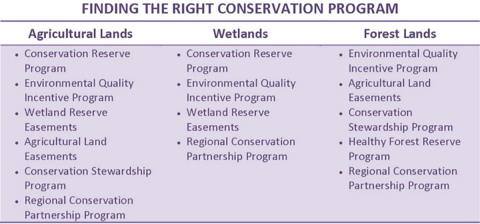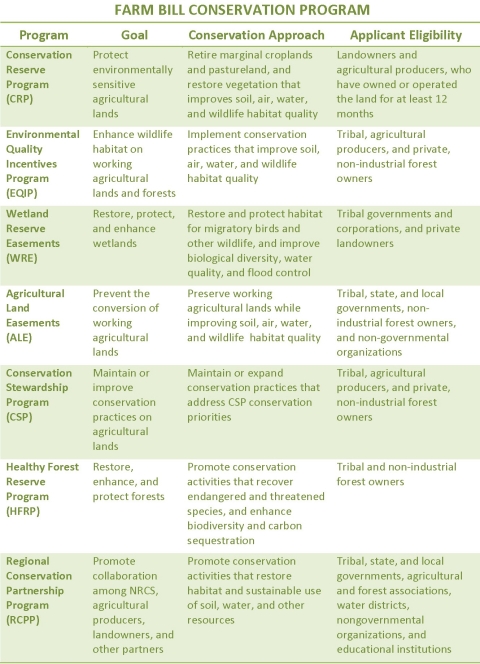Farm Bill Conservation Programs offer financial and technical help for landowners and agricultural producers. Through the U.S. Department of Agriculture’s Natural Resources Conservation Service (NRCS) and Farm Service Agency (FSA) these programs support voluntary conservation practices that benefit both the environment and agricultural operations. For example, a farmer can receive assistance to retire marginal cropland and restore waterfowl habitat.
“The Farm Bill provides billions of dollars annually for voluntary habitat conservation on private lands under agricultural and nonindustrial forest use.” — Dave Walker, U.S. Fish and Wildlife Service’s Farm Conservation Program Coordinator
“The Farm Bill conservation programs are great examples of public-private partnerships that underlie wildlife management in our country. Landowners can improve their agricultural operations, while helping wildlife and other public resources, such as water and air quality. It’s a true win-win!” — Steve Jester, Partners for Conservation
Want more help?
The U.S. Fish and Wildlife Service’s Coastal Program works with willing partners to implement voluntary, agricultural and habitat conservation practices that benefit fish, wildlife, and people. We provide technical and financial assistance to landowners and agricultural producers, and help them to access resources available through the Farm Bill conservation programs. From the mountains to the shores, we can help partners improve the productivity of their working lands for future generations.
Check out the Farm Bill Conservation Program Webinar or the Farm Bill Brochure to learn more about how the these programs can help you!
Highlight Projects
Here are some projects that used Coastal Program and Farm Bill conservation program technical and financial assistance.
Maine Culvert Replacement
Undersized road culverts obstruct fish passage fish passage
Fish passage is the ability of fish or other aquatic species to move freely throughout their life to find food, reproduce, and complete their natural migration cycles. Millions of barriers to fish passage across the country are fragmenting habitat and leading to species declines. The U.S. Fish and Wildlife Service's National Fish Passage Program is working to reconnect watersheds to benefit both wildlife and people.
Learn more about fish passage and threaten public safety with accelerated flows, erosion, and increased flooding. In Maine, the Appalachian Mountain Club, NRCS, and the Coastal Program are working together to replace undersized culverts with bridges, using EQIP assistance provided by NRCS. Located in a private, non-industrial forest, the photographs show the undersized culvert (left) and the new bridge (right) over a brook trout tributary to the Penobscot River.
Texas Coastal Prairies and Wetlands
Coastal prairies, wetlands, marshes are among the rarest habitats along the Gulf of Mexico. These habitats provide nurseries for commercial and recreational fisheries, and wintering habitat for waterfowl, as well as habitat for the endangered aplomado falcon (pictured), Attwater’s prairie chicken, and whooping crane.
In Texas, several ranchers recognizing the importance of these habitats are working to restore and protect them through the WRE program. Working with the Coastal Bend Bays and Estuaries Program, Coastal Program, and Natural Resources Conservation Service, the ranchers restored over 6,400 acres and protected over 2,000 acres of coastal habitat. Other partners included the U.S. Fish and Wildlife Service’s Partners for Fish and Wildlife Program, Texas Parks and Wildlife Department, and The Peregrine Fund.
Washington Coastal Lagoon
In Puget Sound, Dugualla Bay provides important habitat for young Chinook and other salmon before their journey to the ocean. Using EQIP assistance, a diverse partnership restored the connection of a stream to the coastal lagoon that will improve hydrology, water quality, and fish passage within the bay. The partnership includes private landowners, Whidbey Camano Land Trust, Washington State Salmon Recovery Funding Board, Natural Resource Conservation Service, and the Coastal Program.
California Red-Legged Frog Recovery
Amphibian populations are declining and malformations are increasingly common. These impacts are concerning because the success of amphibians can be viewed as a measure of environmental health. The most significant cause of these impacts is habitat loss and degradation (e.g., pollution and invasive species invasive species
An invasive species is any plant or animal that has spread or been introduced into a new area where they are, or could, cause harm to the environment, economy, or human, animal, or plant health. Their unwelcome presence can destroy ecosystems and cost millions of dollars.
Learn more about invasive species ).
In California, private landowners worked the Resource Conservation District of Santa Cruz, NRCS, and Coastal Program to permanently protect 25 acres of habitat and restore a freshwater wetland and pond using WRE assistance. An agricultural buffer was established on the protected land to improve water quality; while, the wetland and pond will provide important habitat for the threatened California red-legged frog and other native species.
For more information, check out our Farm Bill brochure. More help is available through the U.S. Fish and Wildlife Service’s Coastal Program regional contacts.










